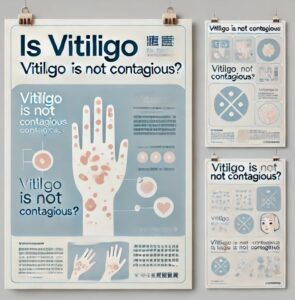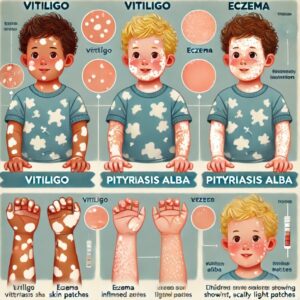Vitiligo, a common skin condition that leads to the loss of pigment and the appearance of white patches on the skin, often raises concerns about whether it is contagious. Parents, educators, and peers of children with vitiligo may worry about the potential for the disease to spread. However, vitiligo is not contagious and cannot be transmitted through physical contact or other means. Understanding vitiligo, especially its impact on children, is essential to dispel myths and foster a more supportive environment for those affected.
What is Vitiligo?
Vitiligo occurs when melanocytes, the cells responsible for producing melanin (the pigment that gives skin its color), are damaged or destroyed. Without melanocytes, the skin loses its pigment, creating white patches of varying shapes and sizes. These patches may appear on different parts of the body, including the face, hands, arms, and legs.
While the exact cause of vitiligo remains unclear, researchers believe it is an autoimmune condition. In autoimmune diseases, the body's immune system mistakenly attacks its own healthy cells. For vitiligo, this means the immune system targets melanocytes, leading to their destruction.
Vitiligo is also thought to have genetic factors, as it can run in families. Additionally, certain environmental triggers, such as sunburn, stress, or exposure to chemicals, may play a role in triggering the condition in susceptible individuals.
Can Vitiligo Spread Through Contact?
One of the most common misconceptions about vitiligo is that it can be passed from person to person through physical contact, shared objects, or even the air. This belief can lead to unnecessary stigma and social isolation for children with the condition. Vitiligo is not caused by any bacteria, virus, or fungus, which are the usual culprits behind contagious diseases. Instead, it is a condition related to the immune system and genetics.
Children with vitiligo should not be treated differently in terms of physical interaction. They can share toys, touch, and engage in normal activities with their peers without any risk of spreading vitiligo. Educating others about the non-contagious nature of the disease is crucial for promoting acceptance and reducing discrimination.
Impact on Children with Vitiligo
Although vitiligo is not harmful to a child's physical health, it can have significant emotional and psychological effects. Children with vitiligo may experience:
- Self-consciousness: The noticeable contrast between the white patches and normal skin can make children feel embarrassed or anxious about their appearance.
- Bullying or teasing: Kids with visible differences are sometimes targets of teasing or bullying, which can further affect their self-esteem.
- Social isolation: Due to misconceptions about vitiligo, some children may be excluded from social activities, leading to feelings of loneliness.
It’s essential for parents, teachers, and friends to provide emotional support and ensure that the child understands that vitiligo does not define their worth or abilities. Providing factual information about the condition can help build a more inclusive and compassionate environment.
Prevention and Management of Vitiligo
There is currently no way to completely prevent vitiligo, especially if it has a genetic component. However, managing the condition and minimizing its impact can help improve the quality of life for children with vitiligo. Here are a few strategies:
- Sun Protection: Vitiligo-affected skin lacks melanin, which normally protects against UV radiation. To prevent sunburn and further skin damage, it’s important to apply sunscreen with high SPF, wear protective clothing, and avoid prolonged sun exposure.
- Cosmetic Camouflage: Some children may feel more comfortable using makeup or self-tanning products to mask the white patches, especially for special occasions or when appearing in public. This can help boost their confidence in social situations.
- Psychological Support: Counseling or therapy may be beneficial for children struggling with self-esteem or social anxiety due to vitiligo. Support groups or online communities can also offer comfort, as children and their families connect with others facing similar challenges.
- Medical Treatments: While there is no cure for vitiligo, several treatments aim to restore skin color or slow the spread of the disease. These include topical corticosteroids, light therapy (UVB), and in some cases, depigmentation therapy, which evens out skin tone by removing the remaining pigment. Treatments should always be discussed with a healthcare provider to determine the best course of action for the child.
Foods to Avoid and Diet Considerations
While there is no definitive "cure" for vitiligo through diet, certain foods may have an impact on autoimmune conditions and skin health. Avoiding certain foods may help reduce inflammation, which is a common trigger for many autoimmune reactions, including vitiligo.
Here are some foods to consider limiting:
- Processed Foods: Foods high in refined sugars, unhealthy fats, and preservatives can promote inflammation, potentially exacerbating autoimmune conditions. Minimizing processed snacks, sugary cereals, and fast food may benefit overall health.
- Citrus Fruits: Some studies suggest that citrus fruits like oranges and lemons could trigger vitiligo in sensitive individuals, though the evidence is limited. Consulting a doctor before making dietary changes is always advisable.
- Gluten: In some cases, gluten has been linked to autoimmune disorders, though this connection with vitiligo is not widely proven. Nevertheless, reducing gluten may be beneficial for individuals with other autoimmune conditions.
Recommended Recipes for Children with Vitiligo
A balanced, nutritious diet can support overall skin health and the immune system. Here is a simple recipe idea that emphasizes whole, anti-inflammatory foods:
Quinoa Salad with Avocado and Mixed Vegetables
- Ingredients:
- 1 cup quinoa (cooked)
- 1 ripe avocado (sliced)
- 1/2 cucumber (diced)
- 1/4 cup cherry tomatoes (halved)
- 1/4 cup spinach or other leafy greens
- 1 tablespoon olive oil
- 1 tablespoon lemon juice
- Salt and pepper to taste
- Instructions:
- Cook quinoa according to package instructions and allow it to cool.
- In a large bowl, mix quinoa, avocado, cucumber, tomatoes, and spinach.
- Drizzle olive oil and lemon juice over the salad. Toss gently.
- Season with salt and pepper to taste.
- Serve chilled as a refreshing and nutritious meal.
This salad provides a healthy source of antioxidants, vitamins, and essential fatty acids, which are beneficial for skin health and may help reduce inflammation.
Conclusion
Vitiligo is not contagious, and children with this condition should not face stigma or social isolation due to misconceptions. By educating ourselves and those around us, we can create a supportive environment that encourages understanding and acceptance. A balanced diet, sun protection, and appropriate medical care can all contribute to managing vitiligo effectively and improving the overall well-being of affected children.
References:
- Vitiligo: A Review - National Institutes of Health (NIH)
- Understanding Vitiligo - American Academy of Dermatology (AAD)
- Vitiligo: Facts and Myths - National Vitiligo Foundation
- Myths About Vitiligo - Mayo Clinic














